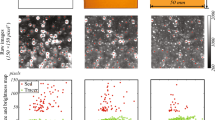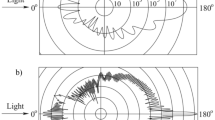Abstract
Dispersed two phase flows cover a wide range of natural phenomenon and technological applications. When studying such complex systems, having access to the velocities of both phases is necessary to fully understand their dynamics. In experiments, inertial particles have to be distinguished from tracers which image the movement of the carrier fluid. For this, most studies rely on differences in size or brightness. This article presents a method for separating particles and tracers if those are of similar size and brightness. It employs fluorescent tracers and a two camera acquisition system. One camera records both particles and tracers, while the second camera only records the tracers by using an optical filter for the fluorescent light. A straightforward image processing algorithm then identifies and removes the tracers from the first image. This allows for the velocities and positions of the particles to be measured in conjunction with the velocity field of the carrying phase. A series of tests are performed on the method to demonstrate its reliability. In addition to ensuring that the method functions in a satisfactory manner, these tests give guidelines on how to use the method correctly. To illustrate an application of this method, measurement results of ceramic particles settling in still water are presented.
Graphic abstract
















Similar content being viewed by others
References
Aliseda A, Cartellier A, Hainaux F, Lasheras JC (2002) Effect of preferential concentration on the settling velocity of heavy particles in homogeneous isotropic turbulence. J Fluid Mech 468:77–105
Brown GL, Roshko A (1974) On density effects and large structure in turbulent mixing layers. J Fluid Mech 64:775–816
Chen R, Fan LS (1992) Particle image velocimetry for characterizing the flow structure in three-dimensional gas-liquid-solid fluidized beds. Chem Eng Sci 47(13–14):3615–3622
Eaton JK (2009) Two-way coupled turbulence simulations of gas-particle flows using point-particle tracking. Int J Multiph Flow 35(9):792–800
Elghobashi S, Truesdell G (1993) On the two-way interaction between homogeneous turbulence and dispersed solid particles I: turbulence modification. Phys Fluids A Fluid Dynam 5:1790
Elhimer M, Praud O, Marchal M, Cazin S, Bazile R (2017) Simultaneous PIV/PTV velocimetry technique in a turbulent particle-laden flow. J Vis 20(2):289–304
Falkovich G, Fouxon A, Stepanov MG (2002) Acceleration of rain initiation by cloud turbulence. Nature 419:151–154
Gatignol R (1983) The Faxen formulae for a rigid particle in an unsteady non-uniform Stokes flow. J de Mécanique Théor et Appl 2:143–160
Gustavsson K, Mehlig B (2011) Ergodic and non-ergodic clustering of inertial particles. Europhys Lett 96(6):60012
Haralick RM, Sternberg SR, Zhuang X (1987) Image Analysis Using Mathematical Morphology. IEEE Trans Pattern Anal Mach Intell PAMI 9(4):532–550
Hassan Y, Blanchat T, Seeley C Jr, Canaan R (1992) Simultaneous velocity measurements of both components of a two-phase flow using particle image velocimetry. Int J Multiph Flow 18(3):371–395
Homann H, Bec J (2010) Finite-size effects in the dynamics of neutrally buoyant particles in turbulent flow. J Fluid Mech 651:81–91 (0909.5628)
Huck P, Bateson C, Volk R, Cartellier A, Bourgoin M, Aliseda A (2018) The role of collective effects on settling velocity enhancement for inertial particles in turbulence. J Fluid Mech 846:1059–1075
Khalitov D, Longmire E (2002) Simultaneous two-phase piv by two-parameter phase discrimination. Exp Fluids 32(2):252–268
Kiger K, Pan C (2000) PIV technique for the simultaneous measurement of dilute two-phase flows. J Fluids Eng 122(4):811–818
Lucci F, Ferrante A, Elghobashi S (2010) Modulation of isotropic turbulence by particles of Taylor length-scale size. J Fluid Mech 650:5
Maxey M, Corrsin S (1980) Stokes spheres falling under gravity in cellular flow-fields. APS Bull 25:paper EA6
Maxey MR, Riley JJ (1983) Equation of motion for a small rigid sphere in a nonuniform flow. Phys Fluids 26:883–889
Monchaux R, Dejoan A (2017) Settling velocity and preferential concentration of heavy particles under two-way coupling effects in homogeneous turbulence. Phys Rev Fluids 2(10):104302
Mora DO, Aliseda A, Cartellier A, Obligado M (2018) Pitfalls measuring 1d inertial particle clustering. In: iTi Conference on Turbulence, Springer, pp 221–226
Muste M, Fujita I, Kruger A (1998) Experimental comparison of two laser-based velocimeters for flows with alluvial sand. Exp Fluids 24(4):273–284
Ouellette NT, O’Malley P, Gollub JP (2008) Transport of finite-sized particles in chaotic flow. Phys Rev Lett 101(17):174504
Petersen AJ, Baker L, Coletti F (2019) Experimental study of inertial particles clustering and settling in homogeneous turbulence. J Fluid Mech 864:925–970
Poelma C, Westerweel J, Ooms G (2007) Particle fluid interactions in grid-generated turbulence. J Fluid Mech 589:315–351
Raffel M, Willert CE, Scarano F, Kähler CJ, Wereley ST, Kompenhans J (2018) Particle Image Velocimetry: A Practical Guide, 3rd edn. Springer, New York
Towers D, Towers C, Buckberry C, Reeves M (1999) A colour PIV system employing fluorescent particles for two-phase flow measurements. Meas Sci Technol 10(9):824
Wieneke B (2005) Stereo-PIV using self-calibration on particle images. Exp Fluids 39(2):267–280
Author information
Authors and Affiliations
Corresponding author
Ethics declarations
Conflict of interest
The authors declare that they have no conflict of interest.
Additional information
Publisher's Note
Springer Nature remains neutral with regard to jurisdictional claims in published maps and institutional affiliations.
This work was supported by the French Direction Générale de l’Armement (DGA) through the Agence de l’Innovation de Défense (AID).
Appendix: Exemplary implementation
Appendix: Exemplary implementation
This section outlines an example implementation of the tracer removal method in MATLAB R2016b. The particle image \(I_\mathrm {P}\) and the tracer image \(I_\mathrm {T}\) are stored in the variables I_P and I_T, respectively, as \((N_1\times N_2)\)-matrices of type uint16. The position of the tracers in \(I_\mathrm {T}\) are detected by a threshold value \(th_\mathrm {T}\) of, for example, 35.

The variable B_T holds the binarised image \(B_\mathrm {T}\). For the erosion of \(B_\mathrm {T}\), the structure element \(S_5\) is chosen.

The variable M is a \((N_1\times N_2)\)-matrix of type logical containing the tracer mask \(M\). To calculate the masked particle image \(I_\mathrm {M}\), the mask is applied to \(I_\mathrm {P}\).

The variable I_M is a \((N_1\times N_2)\)-matrix of type uint16 and contains the image \(I_\mathrm {M}\) with only particles remaining. It can now be further evaluated, for example, by applying a PTV algorithm.
Rights and permissions
About this article
Cite this article
De Souza, D., Zürner, T. & Monchaux, R. Simple distinction of similar-looking inertial particles and fluid tracers on camera images. Exp Fluids 62, 114 (2021). https://doi.org/10.1007/s00348-021-03195-7
Received:
Revised:
Accepted:
Published:
DOI: https://doi.org/10.1007/s00348-021-03195-7




